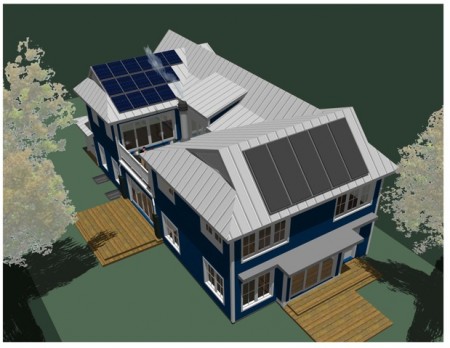Continued from page 2
Why small BIM Now
AFR: As we know the vast majority of architects are working in small practices and we have been going through this BIM revolution now for about ten years–but especially the past five–but a question comes up and I’m going to play devil’s advocate and ask: why jump to BIM now? What is the urgency for small-scale practice today? What do you say to that?
FL: Any moment is a good moment to re-evaluate how important our contribution is to society and how we practice. Maybe ten years ago there would have been some political rhetoric that would have made the climate argument challenging but we are here now and that rhetoric has lost its punch. It’s by now been solidly established that what we do as a society has an [environmental] impact.
I think that the large project, larger firm BIM trend is inevitably having an impact on our whole industry. And strictly from a professional practice viewpoint, I would like to see that we avoid this schism emerging between large firms and small firms due to BIM. Architects, especially early in their careers, tend to bounce around a fair bit between firms. If there is going to be this technical BIM barrier between large and small firm practice then that is going to have an impact and ultimately affect the architecture industry.
AFR: Your last point is very well taken and addresses cultural issues in firms around BIM, something we spoke about extensively in our 2010 BIM Report.
Okay, let’s talk about the bigBIM-smallBIM issue a bit more relative to the tools. Now you do a good job in your book describing the various BIM software tools for architects. But how would you characterize them, based on your research and knowledge, in relation to the bigBIM-littleBIM issue? Who’s doing the better job at addressing smallBIM issues?
FL: Well, I’d like to rephrase that as designBIM versus collaborativeBIM.
AFR: Okay…
FL: From my experience, products like Vectorworks and ArchiCAD–particulary Vectorworks. And of course you are aware from my book my bias as a practitioner on Vectorworks is noted. So I want to make that clear right now. These products, and in my case particularly Vectorworks, give me opportunities to free-form model–like I would with SketchUp but on steroids with powerful NURBS–and at the same time benefit me down the line with standard BIM tools for interoperability and IFC. I also can produce great looking drawings too.
Products like ArchiCAD, with its server-side solutions. That’s a real strength for the collaborativeBIM market. And Graphisoft is a leader there, clearly. But it is only a matter of time before everyone in the market goes there.
AFR: Yes, it’s only a matter of time. Can’t you say that about everyone’s BIM?
FL: Perhaps. And then Revit of course has its own strength and weaknesses like the others. What I try to focus on is addressing the needs that firms have and finding the right BIM product for them. Otherwise it’s like trying to tell everyone that they should drive the same kind of car.

05 - By positioning trees and other obstructions in the BIM model, positioning of collector arrays can be optimized to avoid shading year round. (image courtesy: Nathan Kipnis, AIA, LEED AP)
The focus should be on workflow. Each office has its preferred workflow based on what types of building types they do, what market they are in, and how they as individuals uniquely offer architectural services for those markets.
AFR: So the bigBIM-littleBIM kinda correlates to the collaborativeBIM versus designBIM–that’s how you see it?
FL: Yeah, that’s how I see it.
AFR: Right, and correct me if I am wrong but you are not really characterizing any particular BIM software as being any more one or the other but that particular firms and what they do and how big or small they are determines a particular set of needs. So the big firm will likely have a heavier emphasis on “collaboration” than say the smaller firm. But that doesn’t make them any less of a “design-firm” or design oriented practice.
FL: Yes that’s all true. And what I’m saying is that it is not that the small firm doesn’t need to collaborate or it’s not important to do so but rather generally speaking they will collaborate with a smaller number of stakeholders than the larger practice.
In my experience, for instance, you may not have many opportunities to do BIM collaboration with structural engineers serving the smaller building market. They may still be doing things the way they have since the early 90’s. That affects your opportunities for BIM collaboration. In the larger building markets, it has often been the contractors who have initiated BIM for benefits like clash detection to save on construction costs and reduce errors. They have a significant incentive and that has contributed to the adoption of BIM.
Similarly, clients and owners of large buildings have a vested interest on the facility side of managing their data in the BIM. For the most part very few small building owners, particularly in residential, have any knowledge much less interest in keeping BIM data.





Reader Comments
Comments for this story are closed